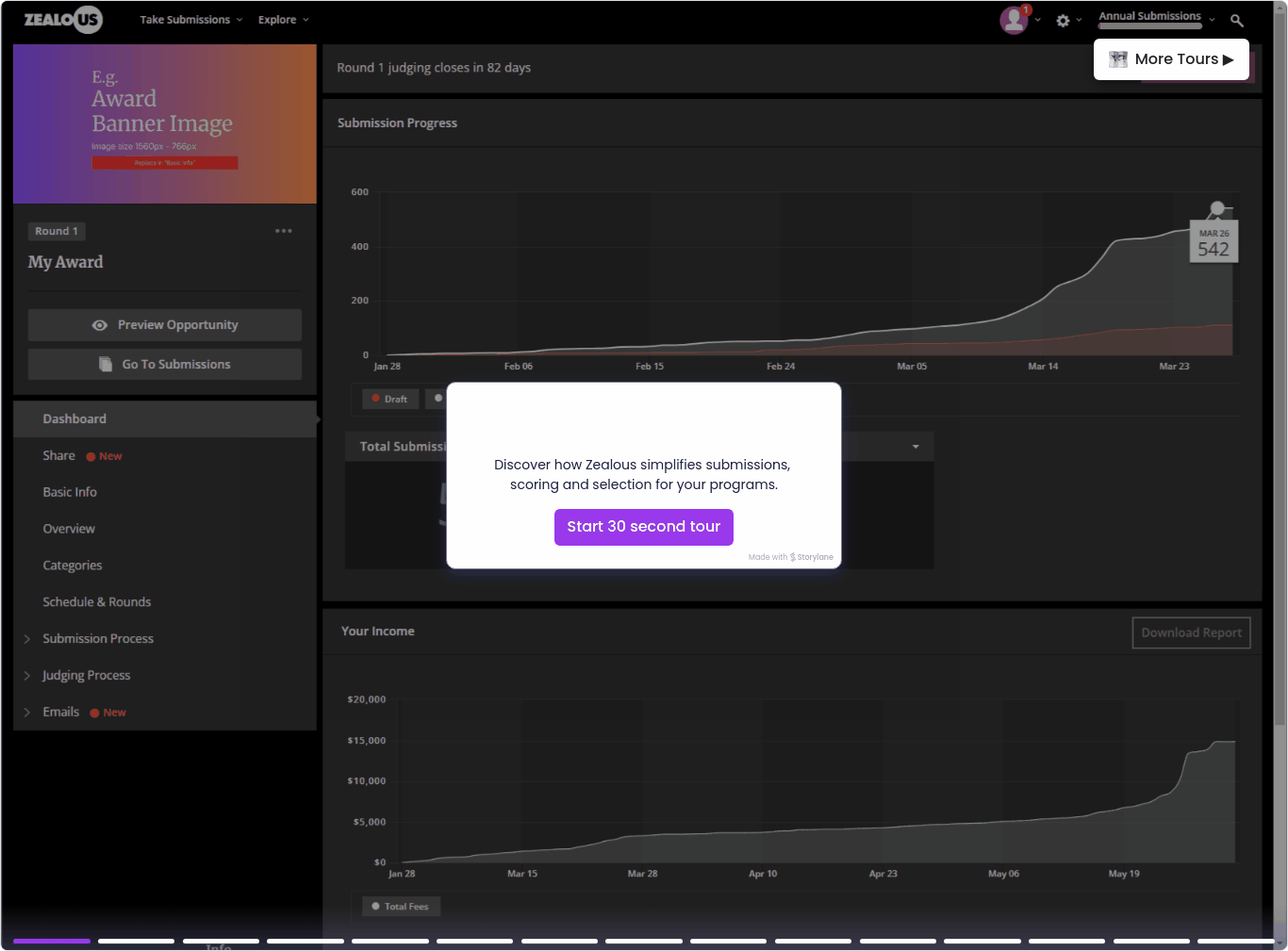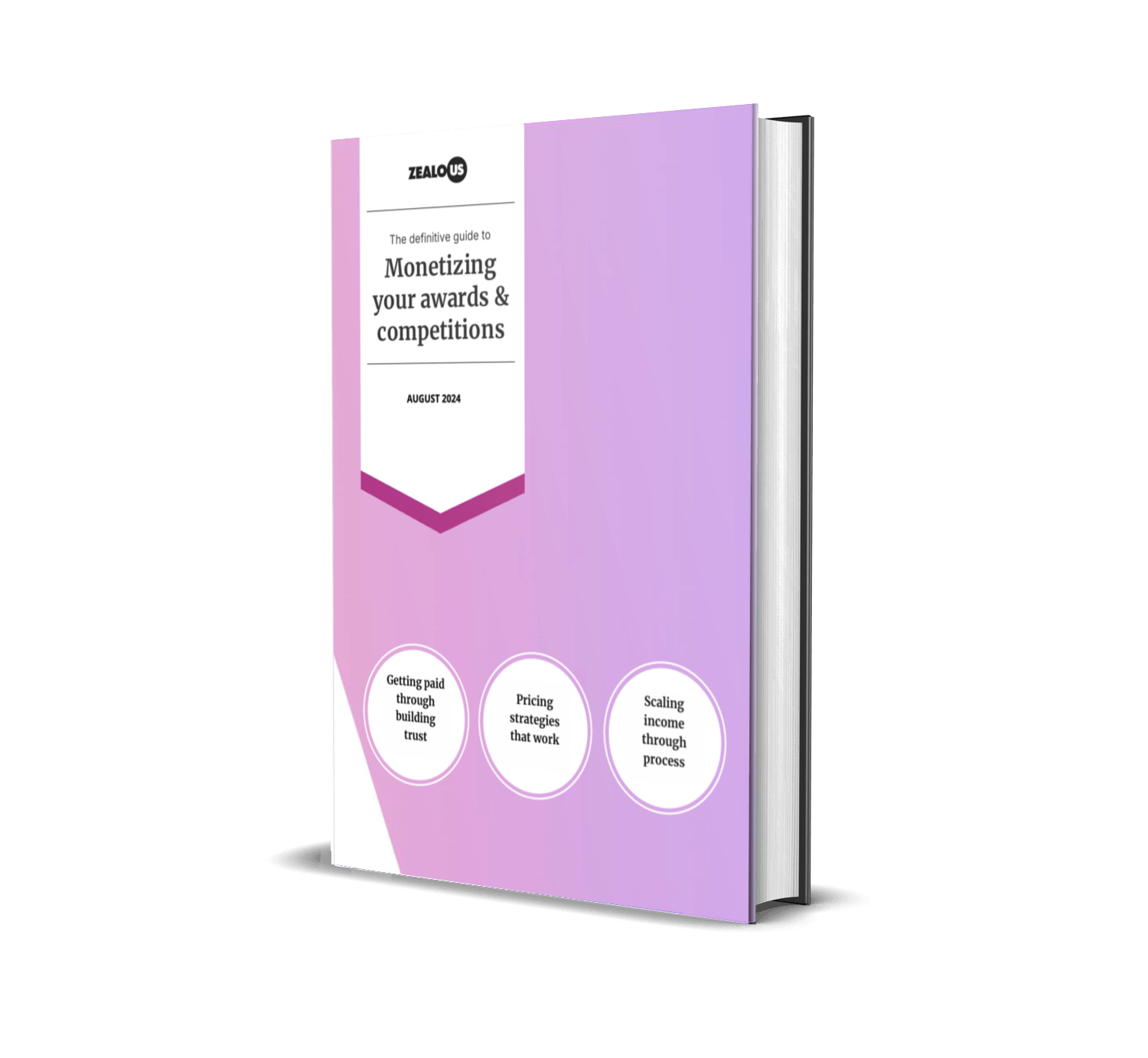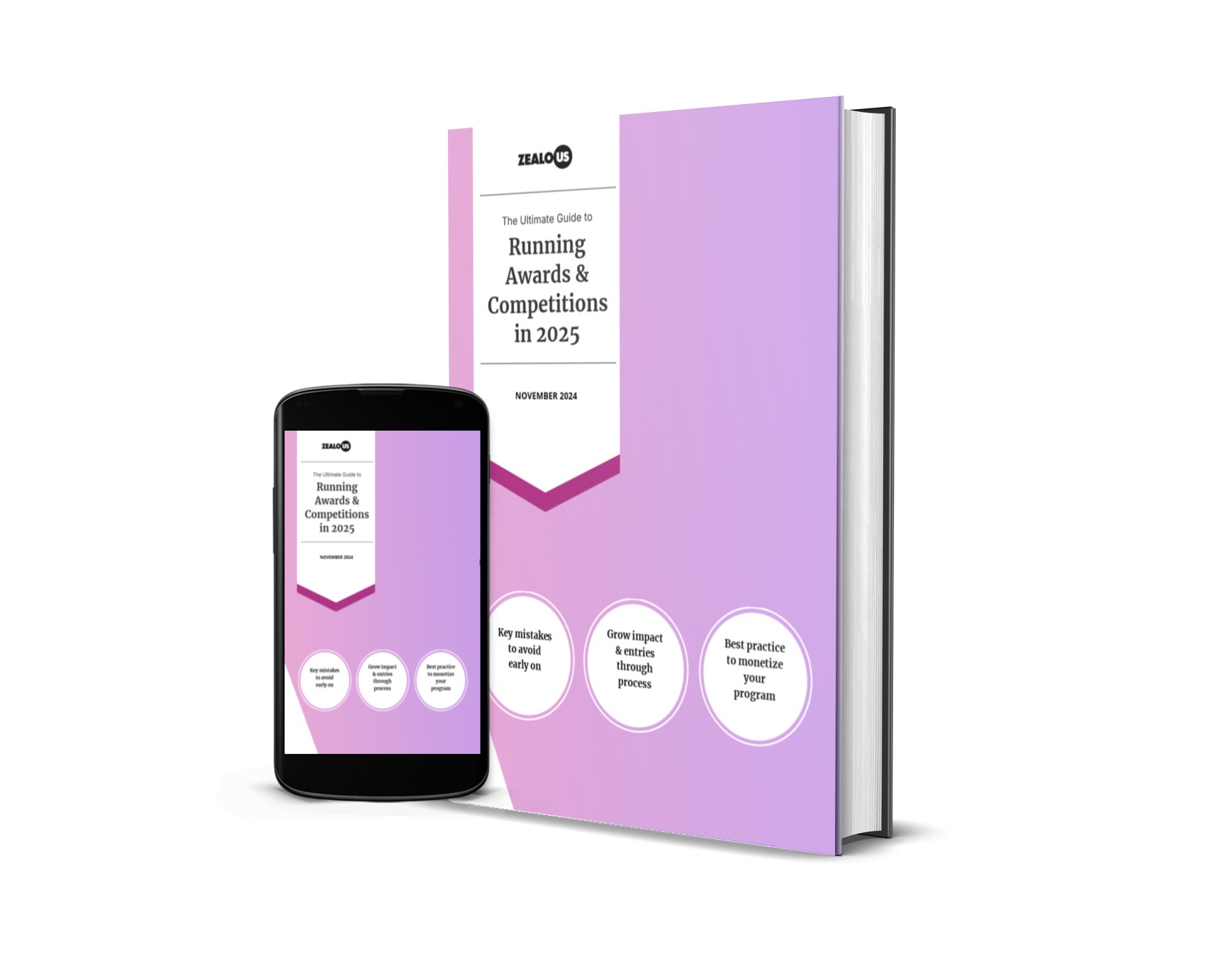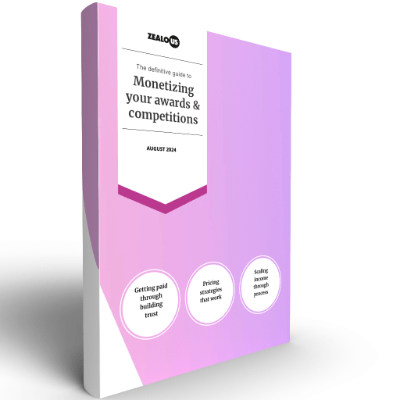This article covers AI prompts for inaugural, established, corporate and student awards to:
- Find the optimal price point to hit your revenue targets
- Ensure prices reflects the financial realities of your audience (don’t price out valuable candidates)
- Testing new pricing for existing awards
- Analyze your competitors pricing strategies
- Integrating your pricing within your communications
Powerful AI prompts to boost your awards pricing strategies
Setting the right price for your award submissions is a delicate balancing act. Charge too much, and you risk excluding talented individuals and limiting your pool of applicants. Charge too little, and you may struggle to cover costs or be overwhelmed with submissions of varying quality.
This challenge becomes more complex when you consider the diverse financial backgrounds of your potential applicants.
We previously covered how to price your competition in this article which covers the thinking process behind effective awards pricing strategies. This article focuses on using these insights to make use of AI tools to allow for more nuanced pricing decisions based on your exact needs.
These insights should you to scale entries without sacrificing on quality, or your bottom line.
A few notes before we begin
- We recommend using Claude to run these prompts since they protect your data – but these prompts should work equally well on most services.
- Items in bold on the prompt should be filled out to match your exact needs. The more detailed these are, the better the results will be from the AI.
- If you upload documents, such as historical data, anonymize all data before uploading it (some AI’s will use uploaded data as part of their training datasets!)
Prompt 1
Discovering your optimal price point
The AI response will present scenarios with different price points and their projected impacts on both submission numbers and total revenue. This gives you a more informed basis for your decision.
One of the biggest challenges is determining a base price that balances your revenue needs with accessibility. Too often, organizations either guess or simply copy competitors without considering their specific circumstances.
Remember that this analysis should be one input in your decision, not the sole determinant. Your brand positioning, accessibility goals, and the value you provide to applicants should all factor into your final pricing strategy.
Click to view prompt for Inaugural Awards (New Awards)
I need to raise [total amount needed] from my inaugural [award name] submissions to cover costs and generate a [percentage] profit margin. As a new award program, I estimate approximately [estimated number] of applicants based on [research method].
My award offers [list specific benefits/prizes] and targets [describe target demographic]. We're positioning this award as [unique value proposition] in an established market. The award has [regional/national/international] scope.
Submitting requires [simple form/detailed documentation/portfolio/etc.], and the submission window is [length]. Judging is conducted by [panel description], which is a key credibility factor for our new program. Submission decisions are typically made by [level/role] within organizations. Applicants can submit to [single category/multiple categories].
What would be an optimal base price point that balances revenue needs with market penetration? Please research current pricing structures for similar awards in this industry and include this analysis in your response. Also suggest:
- How this price might affect submission volumes for a first-year award.
- A sensitivity analysis showing how different price points impact both submissions and revenue
- Early-bird or promotional pricing strategies to build initial momentum
- Marketing angles to maximize perceived value despite our lack of established reputation
Click to view prompt for Established Awards
I need to raise [total amount needed] from my established [award name] submissions to cover costs and generate a [percentage] profit margin. Based on [X] years of historical data, we expect approximately [estimated number] of applicants.
Our award offers [list specific benefits/prizes] and targets [describe target demographic]. We've built a reputation for [key distinguishing factors] over [X] years in operation. The award has [regional/national/international] scope.
Our current pricing is [amount]. Submitting requires [simple form/detailed documentation/portfolio/etc.], and the submission window is [length]. Judging is conducted by [panel description]. Submission decisions are typically made by [level/role] within organizations. Applicants can submit to [single category/multiple categories].
What would be an optimal base price point that leverages our reputation while remaining competitive? Please research current market rates for similar established awards and include this analysis in your response. Also suggest:
- Strategies to communicate increased value if we're raising prices
- How this price might affect submission volumes compared to previous years
- A sensitivity analysis showing how different price points impact both submissions and revenue
- Any premium pricing opportunities based on our established reputation
Click to view prompt for Corporate Awards
I need to raise [total amount needed] from my corporate [award name] submissions to cover costs and generate a [percentage] profit margin. Based on [research/historical data], we expect approximately [estimated number] of corporate applicants.
Our award offers [list business-focused benefits like publicity, networking, recognition] and targets [specific industries/company sizes]. The primary value for entrants is [key corporate benefit]. The award has [regional/national/international] scope.
Submitting requires [simple form/detailed documentation/portfolio/etc.], and the submission window is [length]. Judging is conducted by [panel description]. Submission decisions are typically made by [level/role] within companies (e.g., marketing director, C-suite). Applicants can submit to [single category/multiple categories/unlimited entries].
What would be an optimal base price point for this corporate award? Please research typical pricing for corporate recognition programs and include this analysis in your response. Also suggest:
- Package options that might appeal to corporate clients (multiple submissions, sponsorship opportunities, etc.)
- How this price point positions us in the corporate awards market
- A sensitivity analysis showing how different price points impact both submissions and revenue
- Tiered pricing structures based on company size or submission categories
Click to view prompt for Student Awards
I need to raise [total amount needed] from my student [award name] submissions to cover costs and generate a [percentage] profit margin. Based on [research/historical data], we expect approximately [estimated number] of student applicants.
Our award offers [list specific benefits valuable to students: recognition, mentorship, career opportunities] and targets [specific educational levels/fields]. We recognize the financial constraints of our student demographic. The award has [regional/national/international] scope and [does/does not] include international students.
Our institutional partnerships include [any university affiliations/sponsorships]. Submitting requires [simple form/detailed documentation/portfolio/etc.], and the submission window is [length]. Judging is conducted by [panel description]. Applicants can submit to [single category/multiple categories].
What would be an optimal base price point considering students' price sensitivity? Please research current pricing for student-focused awards and include this analysis in your response. Also suggest:
- Alternative funding models to keep student prices low while meeting revenue goals (sponsorships, institutional partnerships, etc.)
- How this price might affect submission volumes in the student market
- A sensitivity analysis showing how different price points impact both submissions and revenue
- Discount structures (early bird, group submissions from same institution, etc.)
Prompt 2
Test your price point against your audience
Before setting any prices, you need to understand who your potential applicants are and what their financial capacity might be. This is where AI can provide valuable insights that might otherwise take weeks of research.
The prompt below will help you understand the economic realities of your target applicants. It aims to reveal insights based on your specific audience – such as emerging documentary filmmakers having sporadic income patterns and significant equipment costs, making lump-sum fees challenging.
With this understanding, you can then consider whether your pricing strategy should account for these realities.
Click to view prompt for Inaugural Awards (New Awards)
I'm organizing a new award for [specific creative field] in [geographic region] that will launch this year. My target applicants are [age, career stage, other demographics].
Please provide a detailed analysis of this demographic's financial landscape:
- What's the typical income range for these professionals, with variations by sub-region or country where relevant?
- What major expenses and financial priorities compete for their resources?
- Please extrapolate reasonable submission fee ranges for similar awards in this field, citing specific examples where possible.
- What would candidates typically expect to receive in return for these submission fees, and what unique value propositions would be most compelling for this specific demographic?
- What financial and non-financial barriers might affect participation (payment systems, language, time constraints, application complexity, technological access)?
If specific data for this exact demographic/field is limited, please indicate what adjacent categories might provide useful insights, while being transparent about the limitations.
How should we approach situations where there are significant economic disparities within our target demographic? What flexible approaches could accommodate these differences while remaining culturally sensitive and appropriate?
For context, our primary goal is to [recognize achievement/provide funding/increase visibility], and submissions will require [specific requirements like completed works/time commitment].
We [do/don't] have sponsorship that could offset costs. Beyond standard tiered pricing or fee waivers, what innovative fee and value structures might work best for this specific demographic?
What simple, low-cost research methods could we use to test these pricing assumptions before implementation? How could we build flexibility into our fee structure to adapt to changing economic conditions or political considerations in the region?
If the market for similar awards is already saturated, how might we differentiate our offering beyond pricing?
Click to view prompt for Established Awards
I'm organizing the [X]th annual award for [specific creative field] in [geographic region]. My target applicants are [age, career stage, other demographics].
In previous years, we've charged [previous fee amount] and received approximately [number] submissions, with [any participation patterns]. I need a comprehensive analysis to optimize our approach:
- What are the current financial realities for this demographic, with specific breakdowns by sub-region, career stage, or organization size?
- What economic, political, or industry changes since our last award cycle might influence participants' ability or willingness to pay?
- Please analyze 3-5 comparable awards (including their fee structures and value offerings) and assess our current positioning.
- What combination of fee structure and value proposition would best serve our goals while respecting our applicants' constraints?
- What underlying factors beyond price might explain participation patterns we've observed?
If reliable data for this specific field is unavailable, what adjacent industries or award types could provide useful references? Please be transparent about any limitations in your analysis.
How should we handle significant currency fluctuations, political restrictions, or economic instability in our pricing approach? What adaptable pricing mechanisms could respond to changing conditions throughout our submission period? What security or legal considerations should inform our approach?
For fields undergoing significant transformation or decline, how might our pricing strategy accommodate both struggling participants and thriving ones?
Our award's purpose is [recognition/funding/visibility], and we require [submission requirements].
We [do/don't] have sponsorship support. What administrative, technical, or psychological barriers might interact with our pricing decisions? How can we validate any assumptions in this analysis before implementing changes? What key metrics should we track to measure the success of any fee structure changes?
If we're operating in a crowded award landscape, how can we differentiate our offering or consider strategic partnerships rather than direct competition?
Click to view prompt for Corporate Awards
I'm organizing a [new/recurring] award program for [specific business sector] in [geographic region]. Target applicants are [company size, department, career level].
Please provide a data-driven analysis including:
- Typical departmental budgets for these organizations, with sources and segmentation by company size/industry
- Corporate financial cycles and approval processes that might impact participation
- A competitive analysis of 3-5 similar awards, including their fee structures, value propositions, and participation rates if available
- What specific benefits would justify different price points for this demographic, beyond generic networking or recognition?
- What organizational or cultural factors (beyond financial capacity) might influence participation rates?
- What organizational approval processes might impact participation beyond budget considerations? How far in advance should pricing be announced to accommodate complex corporate decision-making? What non-financial decision factors might outweigh price considerations for this type of organization?
For industries in transition or decline, how might we balance inclusivity for struggling segments while maintaining the award's prestige and sustainability?
If data for this specific sector is limited, what adjacent industries could provide useful insights, while noting the limitations of such comparisons?
Our award focuses on [specific achievement/innovation], requiring [submission requirements].
What research methods would you recommend to validate these financial insights before finalizing our approach? How should we measure the impact of our pricing decisions on both quantity and quality of submissions? How could we build flexibility into our structure to adapt to changing business conditions?
In a field with established competitions, should we consider partnership approaches rather than creating direct competition?
Click to view prompt for Student Awards
I'm [launching/continuing] an award for [specific academic field] students in [geographic region]. Our applicants are primarily [education level, institution types, other demographics].
Recognizing the financial constraints of students, please provide:
- A detailed breakdown of financial capacity across different institution types, countries, and funding situations
- Analysis of competing demands on student budgets, including academic expenses, living costs, and field-specific requirements
- Benchmark data from 3-5 comparable student competitions, including their fee structures and participation rates
- What specific, tangible benefits would students most value at different price points, particularly benefits that advance their academic or career goals?
- What non-financial barriers might limit participation, and how might these interact with financial considerations?
How can we implement differential pricing that maintains dignity and doesn't create stigma? What verification systems for financial need are both effective and respectful? Is a single award structure appropriate for diverse participants, or should we consider multiple tracks?
How should we address technological access disparities that might affect submission processes or participation? What cultural considerations should inform our pricing and communication approach?
If data for this specific student demographic is limited, what adjacent educational competitions might provide useful references, while acknowledging the limitations?
The award provides [specific benefits/opportunities] and requires [submission requirements]. We [do/don't] have institutional backing.
Beyond traditional fee waivers or institutional rates, what innovative approaches might make this award accessible while maintaining its perceived value? What stakeholders beyond the students themselves should we consider in our fee structure? What simple testing methods could validate our pricing approach before full implementation?
In a landscape already crowded with student competitions, how might we differentiate our offering or consider complementary positioning rather than direct competition with established awards?
Prompt 3
Create agility in your pricing with multi-tiered pricing models modelled on your timelines
Having a single price point often fails to address the diversity of your potential applicants. Creating multiple tiers or pricing options can help you both maximize revenue and ensure inclusivity. But designing these tiers requires careful thought about your specific audience segments and the timings.
This prompt helps you create pricing tiers that respond to your applicants’ actual financial realities rather than arbitrary discounts. For example, you might be recommended timing your early bird deadline right after common paydays in your target industry or creating special rates for students that align with semester financial aid disbursements.
An effective multi-tiered strategy does more than just offer different prices—it shows applicants that you understand their circumstances and have designed a submission process with their needs in mind.
Click to view prompt for Inaugural Awards (New Awards)
I'm launching an inaugural award with submissions open from [start date] to [end date]. As a new award, I need to balance credibility with accessibility while aiming to collect [total revenue needed].
My target demographic is [specific demographic details] and I'm considering a standard submission fee of [amount].
Please help me design:
1. An early bird discount timeline (2-3 tiers) that builds momentum early and attracts first-time applicants, considering typical payment cycles and financial constraints of my target audience
2. A sliding scale payment model (3-4 tiers) that demonstrates inclusivity while maintaining perceived value
3. Clear, non-invasive methods for applicants to self-select their appropriate pricing tier
For each strategy, include specific price points, deadlines, and implementation advice. Since this is a new award, please also suggest how to communicate our pricing approach to establish trust and maximize early participation.
Please include benchmarks from 2-3 similar successful inaugural awards in my field to establish competitive yet credible pricing, with specific examples if possible.
Click to view prompt for Established Awards
I'm organizing an established award with submissions open from [start date] to [end date]. We need to maintain our prestige while improving accessibility, aiming to collect [total revenue needed].
Our award serves [specific demographic details] with a standard submission fee of [amount].
Please help me design:
1. A refined early bird discount timeline (2-3 tiers) that rewards planning while respecting our award's reputation, considering our audience's financial cycles and historical submission patterns
2. A sliding scale payment model (3-4 tiers) that expands our reach without diminishing perceived value
3. Dignified methods for applicants to self-select their appropriate pricing tier based on their circumstances
For each strategy, include specific price points, deadlines, and implementation advice that builds on our established reputation while broadening our applicant pool.
Please suggest effective communication strategies for explaining any pricing changes to returning applicants without devaluing previous years' participation, and include examples from other prestigious awards that have successfully implemented similar pricing models.
Click to view prompt for Corporate Awards
I'm managing a corporate award program with submissions open from [start date] to [end date]. We aim to collect [total revenue needed] while accommodating both large corporations and smaller businesses.
Our award targets [specific industry/professional demographic] with a standard submission fee of [amount].
Please help me design:
1. An early bird discount timeline (2-3 tiers) that aligns with corporate budget cycles and procurement processes, considering fiscal year timing and approval workflows
2. A sliding scale payment model (3-4 tiers) that fairly accommodates organizations of different sizes and resources
3. Objective criteria for companies to self-select their appropriate tier based on metrics like company size, revenue, or other relevant factors
For each strategy, include specific price points, deadlines, and implementation considerations tailored to corporate environments. Please provide specific language and justification templates that procurement departments and budget holders can use to approve the expense.
Include examples of 2-3 successful corporate award programs with similar pricing structures in my industry, highlighting their approach and results if available.
Click to view prompt for Student Awards
I'm organizing a student award with submissions open from [start date] to [end date]. Our primary goal is accessibility while still needing to raise [total revenue needed].
Our award is designed for [specific student demographic/educational level] with a planned standard submission fee of [amount].
Please help me design:
1. An early bird discount timeline (2-3 tiers) that works with academic calendars, student loan disbursement cycles, and extremely limited budgets
2. A sliding scale payment model (3-4 tiers) with a potentially free or nominal fee option for those with significant financial constraints
3. Respectful ways for students to self-select their appropriate tier without requiring proof of financial hardship
For each strategy, include specific price points, deadlines, and implementation advice. Please also suggest ways to communicate these options that emphasize inclusion while maintaining the award's significance.
Additionally, recommend institutional partnership strategies for how schools, departments, or student organizations might sponsor or subsidize entries, with specific examples of successful models from other student awards programs.
Prompt 4
Analyse competing awards pricing strategies
While you shouldn’t simply copy your competitors, understanding the broader landscape helps position your award effectively. AI can help you analyze competitor strategies more thoroughly than a simple price comparison:
This analysis helps you understand not just what prices competitors are charging, but the value proposition behind those prices. The AI might identify that while several competitors offer student discounts, none offer specific rates for early-career professionals who often face financial pressures but don’t qualify for student rates.
Finding these gaps can help you create a pricing strategy that differentiates your award in the marketplace while addressing actual needs of your target applicants.
Prompt valid for all types of awards
I'm developing pricing for my [type: inaugural/established/corporate/student] award in the [industry/field] space. My award is based in [country/region] and primarily targets [geographic scope].
If you know of relevant competing awards in this space, please share details about their submission fees, prize values, prestige level, target audiences, and pricing models.
Here's what I know about some competitors: [optional: list any awards information you have, or write "I don't have detailed information yet"]
My financial goals for this award are [break-even/profit-generating/subsidized], with approximately [amount] available for prize funding. Besides submission fees, I'm considering these additional revenue sources: [sponsorships/grants/merchandise/etc. or "none currently"].
Given that my award offers these unique benefits compared to competitors: [list 2-3 specific differentiating factors], how should I position my pricing relative to competitors in this space? Please provide:
1. Specific recommended price points or ranges based on typical industry standards and any competitor information available
2. Gaps in typical pricing strategies that I could fill to attract underserved segments
3. Pricing innovations I could implement to differentiate my award while remaining financially sustainable
4. A 3-year pricing evolution strategy as my award becomes more established
If my award is in a highly specialized niche where few direct comparisons exist, please suggest how to adapt pricing strategies from adjacent or similar fields.
What are the trade-offs I should consider for each pricing approach, especially regarding perceived value versus accessibility?"
Tired of managing awards with spreadsheets and clunky tools?
Discover how our sleek awards management platform streamlines every aspect of your program from first submission to final celebration .
Prompt 5
Sanity checking and optimising your pricing strategy
AI isn’t perfect and pricing isn’t a set-it-and-forget-it decision. The most successful award programs continually test and refine their approach based on actual results and feedback.
Sanity checking the work above, and analyzing your actual submission data can reveal patterns you might otherwise miss. For example, it might show that your early bird deadline saw strong uptake from students but few professionals, suggesting that the timing might not align well with professional payment cycles.
This kind of continuous refinement based on actual data helps you evolve your pricing strategy to better meet both your financial needs and the needs of your applicant community.
Click to view prompt for Inaugural Awards (New Awards)
I'm planning a pricing strategy for my inaugural [award type] awards program.
Basic information:
- Award domain: [photography/film/art/design/literature/etc.]
- Target audience: [professionals/students/both/corporate]
- Geographic scope: [local/national/international]
- Key competitors: [optional: list main competitors, or I'll identify typical competitors in this space]
Please help me develop a comprehensive pricing strategy based on this information, including:
1. Recommended pricing framework with:
- Suggested price points and tier structure
- Category-specific considerations typical for [award type]
- Early bird and promotional pricing options
- Appropriate balance between accessibility and perceived value
2. Strategic positioning guidance for:
- Market-appropriate pricing relative to similar awards
- Creating perceived value as a new award program
- Establishing credibility with my target audience
- Managing industry-specific submission requirements
3. A/B testing strategy to validate my approach, including:
- Key variables to test
- Audience segmentation recommendations
- Essential metrics to track
- Implementation suggestions
My goals are to maximize participation, establish credibility, and create a sustainable pricing model.
Click to view prompt for Established Awards
I'm planning the pricing strategy for my established [award type] awards program with several years of history.
Basic information:
- Award domain: [photography/film/art/design/literature/etc.]
- Target audience: [professionals/students/both/corporate]
- Geographic scope: [local/national/international]
- Key competitors: [optional: list main competitors, or I'll identify typical competitors in this space]
- Key historical data: see uploaded historical file
Please help me:
1. Analyze my historical data to identify pricing opportunities:
[Include key metrics in uploaded file: entries per category, pricing tiers, revenue, demographics, etc.]
2. Recommend specific pricing adjustments for my next cycle that will:
- Optimize revenue without sacrificing participation
- Address any concerning trends in the data
- Account for our established reputation
- Refine category-specific pricing based on performance
3. Design an A/B testing strategy to further optimize our pricing, including:
- Key variables to test based on our historical performance
- Audience segmentation recommendations
- Critical metrics to track
- Implementation suggestions
My goal is to leverage our established position and previous data to maximize both submissions and revenue while maintaining our reputation for quality and value.
Click to view prompt for Corporate Awards
I'm developing a pricing strategy for a [award type] awards program targeting corporate participants.
Basic information:
- Award domain: [photography/film/art/design/corporate communications/etc.]
- Target corporate audience: [agencies/in-house teams/both]
- Geographic scope: [local/national/international]
- Key competitors: [optional: list main competitors, or I'll identify typical competitors in this space]
- Program status: [inaugural/established see uploaded data]
Please help me:
1. [If established] Analyze my corporate-specific data to identify insights:
[Include relevant metrics on company participation, payment methods, etc.]
[If inaugural] Recommend a pricing framework appropriate for my corporate audiences.
2. Provide strategic recommendations on:
- Price points aligned with corporate budget expectations
- Tiered pricing based on company size or submission volume
- Bulk/group submission approaches
- Payment options accommodating corporate processes
- Timing strategies aligned with corporate and industry calendars
3. Design an A/B testing strategy specifically for corporate audiences, including:
- Key variables most relevant to organizational decision-makers
- Effective audience segmentation
- Metrics beyond submission numbers
- Implementation approaches respecting corporate processes
My goal is to maximize participation from businesses while establishing pricing that reflects the value proposition of our awards to corporate entities.
Click to view prompt for Student Awards
I'm developing a pricing strategy for a [award type] awards program targeting students and educational institutions.
Basic information:
- Award domain: [photography/film/art/design/literature/etc.]
- Target academic level: [high school/undergraduate/graduate/all]
- Geographic scope: [local/national/international]
- Key competitors: [optional: list main competitors, or I'll identify typical competitors in this space]
- Program status: [inaugural/established with data]
Please help me:
1. [If established] Analyze my student-specific data to identify insights:
[Include relevant metrics on company participation, payment methods, etc.]
[If inaugural] Recommend a pricing framework balancing accessibility with sustainability.
2. Provide strategic recommendations on:
- Affordable price points maximizing student participation
- Institutional partnership approaches
- Potential sponsorship models to offset costs
- Timing strategies aligned with academic calendars
- Discount strategies maintaining perceived value
3. Design an A/B testing strategy for student audiences, including:
- Price sensitivity testing approaches
- Segmentation recommendations
- Key metrics focusing on participation and sustainability
- Implementation approaches accounting for student budget constraints
My goal is to create an inclusive awards program accessible to students while maintaining sufficient revenue to ensure program quality and sustainability.
Bonus Prompt
Crafting value-focused communication
How you communicate your pricing is almost as important as the price itself. Applicants need to clearly understand the value they’re receiving in exchange for their submission fee.
The way you frame your pricing significantly impacts how applicants perceive it. Rather than seeing it as a cost, effective communication helps them understand it as an investment in their careers or creative work.
This is particularly important for higher-priced awards where the value proposition needs to be extremely clear to justify the fee.
Needs Improvement:
“Entry fee: £75”
Good:
“Investment: £75 – This submission fee enables us to provide personalized feedback from industry leaders, showcase finalists in our gallery with 15,000 monthly visitors, and connect winners directly with opportunities valued at over £5,000.”
This prompt will help you craft messaging that effectively communicates your pricing in relation to the value provided:
Prompt valid for all types of awards
Award Pricing Messaging Generator
About my award:
fee_amount: [e.g., £500]
award_type: [e.g., inaugural art prize, established film competition in it's 5th year, corporate award aimed at agencies, psychology student prize]
industry/sector: [e.g., technology, arts, healthcare]
top 2-3 benefits: [e.g., industry recognition, judge feedback]
[Optional: Any special pricing details, history, or context I should know?]
I'll create compelling value-focused messaging for your award fee, with website copy, email text, and social posts that address potential objections.
Conclusion
As the gap in society widens, pricing will become increasingly contentious for award organizers. Price yourself too high, and you’re removing your opportunity from those that may need it the most. Price yourself too low, and you could be putting your organization at risk.
AI tools offer a powerful way to navigate this complex landscape, helping you make more informed, strategic decisions about your pricing strategy. By using these AI prompts as part of your planning process, you can create a pricing approach that balances financial sustainability with inclusivity.
Remember that the goal isn’t just to maximize revenue—it’s to create a pricing structure that allows your award to thrive while remaining accessible to the diverse community of creators you aim to serve. With thoughtful application of AI insights, you can achieve both.
Ready to remove the stress from your programs?
Experience how Zealous simplifies your process for candidates, judges and admins in these 30-second tours.


Guy Armitage is the founder of Zealous and author of “Everyone is Creative“. He is on a mission to amplify the world’s creative potential.
Let us know you want us to write more content like this with a love!
Share








